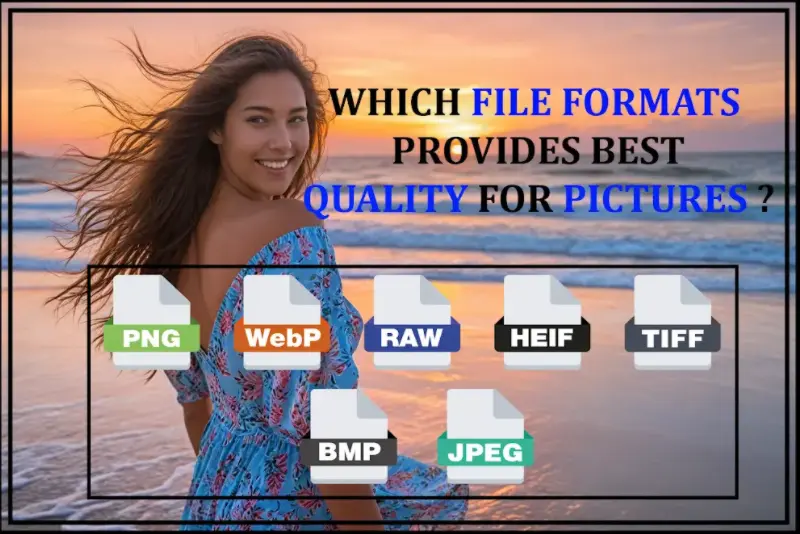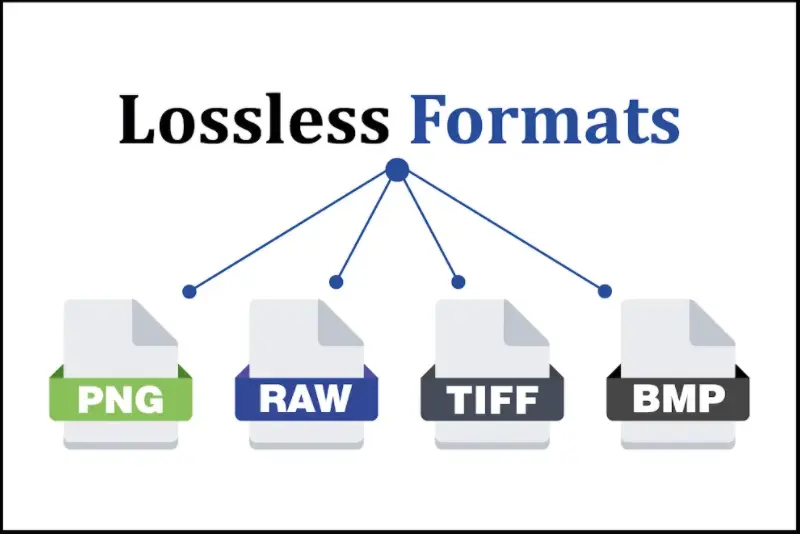WHICH FILE FORMATS PROVIDE BEST QUALITY FOR PICTURES?
Have you ever thought about which FILE FORMATS PROVIDES BEST QUALITY? In today’s world, where images play a crucial role in communication, choosing the right file format can significantly impact how your photos are perceived. Whether you’re a professional photographer, a graphic designer, or someone who simply loves capturing moments, understanding the importance of file formats is essential. This article explores the most common formats, Counting JPEG , PNG , TIFF ,RAW and more, analyzing their quality, compression methods and ideal usage scenarios.
By the end you have a clear understanding of which formats will best suit your needs, ensuring your pictures look their absolute best.
Which File Formats are Best for you to Use for your pictures:
The best file format for pictures depends on the conditions and the specific needs for image quality, compression, and use case.
Table of Contents
A Guide to Quality and Compatibility:
Here are the most common formats and their advantages: So there are two types of formats which are considered Lossless and Lossy, So let’s first talk about Lossless formats:
Lossless Formats
Let’s first talk about Lossless compression? Lossless compression is a form of data that reduces file sizes without sacrificing any significant information in the process – meaning it will not diminish the quality of your photos. No details are lost along the way.
Here are name of the Best lossless file formats for Pictures:
- PNG
- RAW
- TIFF
- BMP
1) PNG:
PNG is a format that is widely used on websites to show high-quality digital images. It is created to exceed the performance of GIF, PNGs offers not just lossless compression, but also a much broader and brighter colour palette. Read on to discover the pros and cons of PNG, their main uses, and how to create a PNG.
What is PNG?
Let’s understand what PNG is, how it works and what the main uses of it are.
PNG (Portable Network Graphics) is a fantastic image format that keeps all the details in your pictures without losing quality. It’s perfect for web graphics, logos, and charts, especially when you need a transparent background or sharp, clear images. Unlike GIFs, PNGs don’t do animations, but they’re amazing at keeping your images looking crisp and clean. So, if you want visuals that pop on your website just as much as they do on your computer, PNG is the way to go!
Now let’s talk about the Pros and Cons of PNG.
Pros of PNG:
- High Quality: PNG keeps all the details in your images with lossless compression, so you don’t lose any quality.
- Transparency: PNG supports transparency, including different levels of opacity, making it perfect for images with see-through backgrounds.
- Rich Colors: It handles a wide range of colors, from simple black-and-white to millions of colors in high definition.
- Reliable: Built-in error detection ensures your files stay intact and display correctly.
- Extra Info: PNGs can store metadata like text comments and color profiles.
Universal Support: PNG is widely supported by web browsers, image editors, and other software.
Cons of PNG:
- Large File Size: PNG can be quite large, especially compared to JPEGs, which can make storage and sharing a bit more cumbersome.
- No Animations: Unlike GIFs, PNGs don’t support animations, so they’re not suitable for animated images.
- Not Ideal for Photos: For photos, JPEG is usually more efficient due to its smaller file sizes.
- Slower Load Times: Bigger file sizes can mean slower load times on websites, which can be a drawback.
Older Browser Issues: Some older web browsers might not fully support PNG features like transparency.
1) RAW:
RAW is a photo format that keeps everything your camera captures exactly as it sees it, without any changes. It’s bigger than other formats because it holds more detail. To edit RAW photos, you’ll need special software designed for them. People love RAW because it lets you make your photos look their very best by adjusting all the details later on.
What is RAW?
Let’s understand what RAW is, how it works and what the main uses of it are.
RAW is like a digital negative in photography. It’s a file format that stores all the raw data straight from your camera’s sensor, keeping every little detail and colour exactly as it was captured. This makes it perfect for photographers who want total control over editing later on. Whether adjusting exposure, fine-tuning colours, or preserving image quality for archival purposes, RAW gives you the freedom to create stunning photos without compromise.
Now let’s talk about the Pros and Cons of RAW file.
Pros of RAW:
- Highest Quality: RAW preserves all original image data for the best possible image quality and detail.
- Flexible Editing: Allows extensive adjustments without losing quality, ideal for correcting exposure and fine-tuning colours.
- Dynamic Range: Captures a wider range of tones, preserving details in both shadows and highlights.
- Non-Destructive: Edits are reversible and don’t affect the original data, great for experimentation and archival purposes.
Cons of RAW:
- Large File Size: RAW are bigger than JPEGs, requiring more storage space.
- Specialised Software: Requires specific programs for viewing and editing, which may have a learning curve.
- Workflow Complexity: Editing RAW can be more time-consuming compared to JPEGs.
Compatibility: Not all devices and software support RAW, requiring conversions for sharing and compatibility.
3) TIFF:
TIFF, which stands for Tagged Image File Format, is a file format commonly used for storing digital images. It is widely appreciated for its ability to preserve image quality without loss of detail, making it popular among photographers and graphic designers.
What is a TIFF?
Let’s understand what TIFF is, how it works and what the main uses of it are.
TIFF, known as Tagged Image File Format, is utilised extensively for storing raster graphics, notably digital photographs, due to its reputation for preserving image quality effectively. This format is widely favoured in professional settings and applications where maintaining high-quality visual data is paramount.
Now let’s talk about the Pros and Cons of the TIFF.
Pros of TIFF:
- Preserves Image Quality: TIFF uses lossless compression, preserving all original image data, which is crucial for tasks like professional photography and printing.
- Versatile: It supports multiple layers, transparency, and various color depths, making it suitable for diverse applications from publishing to archival storage.
- Compatibility: TIFF works seamlessly across different platforms and software, ensuring easy access and usability.
- Flexible Compression: TIFF allows for both lossless and uncompressed storage options, providing flexibility based on specific needs.
Cons of TIFF:
- Large File Sizes: TIFF can be quite large, especially when uncompressed or using lossless compression, requiring more storage space and longer transfer times.
- Complexity: Handling TIFF with multiple layers and high colour depths can be more complex compared to simpler image formats.
- Processing Requirements: Processing TIFF, particularly large ones, may demand more computing power and time, affecting workflow efficiency.
- Not Ideal for Web Use: Due to their larger sizes, TIFF are less suitable for images intended for web display or sharing, where smaller file sizes are preferred for faster loading.
4) BMP:
BMP, or Bitmap, is a file format used for saving digital images. It keeps images pixel by pixel without compressing them, which means it’s straightforward but can lead to larger file sizes compared to formats like JPEG or PNG.
What is a BMP?
Let’s understand what BMP is, how it works and what the main uses of it are.
BMP, or Bitmap, is a file format designed for storing digital images pixel by pixel without compression. People use BMP primarily when they need a straightforward format that preserves image quality without any loss, making it suitable for applications requiring precise pixel-level control or compatibility with older systems and software environments.
Now let’s talk about the Pros and Cons of the BMP.
Pros of BMP:
- Preserves Image Quality: BMP maintain all original image data without any compression, ensuring the highest quality and fidelity.
- Ease of Use: They are straightforward to create, edit, and understand, making them ideal for developers and compatible across different platforms.
- Precise Control: BMP allows for precise control over each pixel’s color and transparency, making it suitable for applications needing exact image representation.
- Compatibility: BMP is widely supported by most image software and systems, particularly in Windows environments.
Cons of BMP:
- Large File Sizes: Due to lack of compression, BMP can be larger than formats like JPEG or PNG, requiring more storage space and longer download times.
- Limited Compression Options: BMP offers minimal compression, which can result in larger files, especially for complex images.
- Not Ideal for Web Use: Their larger file sizes make BMP less suitable for web graphics, where faster loading times are preferred.Older Standards: While BMP’s simplicity is advantageous, it may lack advanced features needed for modern applications.
“Alright Lossless formats section is completed. Now let’s take a look at Lossy formats.”
Lossy Formats:
A lossy format for pictures is a type of file compression used to make image files smaller. It works by removing some details from the original image to reduce its size. This compression helps save storage space and speeds up file transfers, but it can also reduce the image quality slightly.
Here are name of the Best lossy file formats for Pictures:
- JPEG
- WebP
- HEIF
1) JPEG:
JPEG, officially known as Joint Photographic Experts Group, stands as a prevalent file format designed to compress digital images effectively. Through the use of lossy compression, JPEG reduces file sizes by selectively discarding image data deemed less crucial. This approach aims to strike a balance between compact file sizes and retaining acceptable image quality, making JPEG highly suitable for sharing and storing photos across different platforms and devices.
What is a JPEG?
Let’s understand what JPEG is, how it works and what the main uses of it are.
JPEG, or Joint Photographic Experts Group, is a popular file format used extensively for compressing digital images. It utilises lossy compression to reduce file sizes by selectively removing data that is less crucial to the overall image quality. This makes JPEG ideal for applications where saving storage space while retaining decent image quality is essential, such as sharing photos online and storing them in digital photography.
Now let’s talk about the Pros and Cons of JPEG.
Pros of JPEG:
- Efficient for Sharing: JPEG reduce file sizes effectively, making them ideal for sharing photos online without consuming too much storage or bandwidth.
- Wide Compatibility: They are universally supported across devices and platforms, ensuring that photos can be viewed and shared seamlessly.
- Customizable Compression: Users can adjust the compression level when saving JPEGs, balancing file size reduction with acceptable image quality.
Cons of JPEG:
- Loss of Quality: High compression levels can lead to visible loss of image details and introduce artifacts like blurriness or pixelation.
- Permanent Loss: Once a JPEG is saved with high compression, the discarded image data cannot be recovered, limiting subsequent editing without further quality degradation.
- Transparency Limitations: JPEGs do not support transparent backgrounds or layers, which can be restrictive for images requiring overlays or logos with transparent elements.
2) WebP:
WebP is an image format created by Google to make web images load faster. It uses clever ways to make image files smaller without losing much quality. WebP supports both normal images and animations, plus it handles transparency like PNG files. It’s designed to replace older formats like JPEG and PNG with better compression and faster loading times, especially on websites.
What is WebP?
Let’s understand what WebP is, how it works and what the main uses of it are.
WebP is a modern image format created by Google. It uses smart compression techniques to make image files much smaller than JPEG or PNG, without losing much quality. This makes WebP perfect for speeding up website loading times and saving bandwidth. It also supports features like transparency and animation, making it a versatile choice for the web.
Now let’s talk about the Pros and Cons of WebP file.
Pros of WebP:
- Smaller File Sizes: WebP images take up less space than JPEGs or PNGs, making your website load faster and saving storage space.
- High Quality: Even with the reduced file size, WebP keeps your images looking sharp and clear, perfect for both photos and graphics.
- Transparency: WebP supports transparent backgrounds, just like PNGs, which is great for creating overlays or images without backgrounds.
- Animations: You can use WebP for animations too, providing a better alternative to GIFs with smaller sizes and better quality.
- Browser Support: Most modern browsers, like Chrome, Firefox, Edge, and Opera, support WebP, so your images will work well across the web.
Cons of WebP:
- Older Browser Issues: Some older browsers and applications don’t support WebP, which can cause compatibility problems.
- Editing Tools: Not all image editing software supports WebP yet, which might make it harder to create and edit these images.
- Less Common: Since WebP is newer, it’s not as widely used as JPEG or PNG, so you might run into some limitations in certain situations.
3) HEIF:
HEIF, which stands for High Efficiency Image File Format, is a newer image format that makes your pictures look great while taking up less space. It compresses images more efficiently than older formats like JPEG, giving you higher quality photos with smaller file sizes. It can also handle features like bursts of photos and animations.
What is HEIF?
Let’s understand what HEIF is, how it works and what the main uses of it are.
HEIF, or High Efficiency Image File Format, is an advanced image format that provides high-quality images with smaller file sizes compared to traditional formats like JPEG. It is used primarily for storing photos and image sequences efficiently.
Now let’s talk about the Pros and Cons of HEIF file.
Pros of HEIF:
- Better Compression: HEIF can store high-quality images at smaller file sizes compared to JPEG, saving storage space on your devices.
- More Features: It supports features like image sequences, transparency, and 16-bit color depth, offering more flexibility for creative editing and multimedia use.
- Efficiency: HEIF allows for storing multiple images (like burst shots or exposure brackets) and metadata in a single file, making organization and sharing easier.
Cons of HEIF:
- Compatibility: Not all devices and software support HEIF yet, which can limit sharing and editing options.
- Processing Power: Due to its advanced compression techniques, decoding HEIF files may require more processing power, potentially affecting performance on older devices.
- Patent Issues: There have been concerns about patents related to HEIF, which could lead to licensing costs or restrictions for implementing support in devices and software.
FAQs: Choosing the Best File Formats for Your Pictures
1) What are file formats that keep all the details in pictures? When should I use them?
File formats like PNG, RAW, TIFF, and BMP keep all the details of your images without losing any quality. They’re great for professional use, like photography or graphic design, where keeping every detail intact matters a lot.
2) When is PNG format the best choice for my images?
PNG (Portable Network Graphics) is perfect when you need high-quality images with transparent backgrounds, such as logos or graphics for websites. It can handle lots of colors and keeps your images sharp, but it does create larger file sizes compared to JPEG.
3) Why do photographers prefer using RAW format for their pictures?
Photographers love RAW format because it saves all the original data from the camera’s sensor. This allows them to edit photos extensively without losing quality. It’s ideal for adjusting things like exposure and color with precision.
4) What makes TIFF format a good option for pictures?
TIFF (Tagged Image File Format) is excellent for preserving image quality. It’s very versatile and is often used in professional settings like printing and publishing because it can handle layers, transparency, and different color depths effectively.
5) What are the downsides of using BMP format?
BMP (Bitmap) keeps images looking great but produces large file sizes because it doesn’t compress the image data. It’s good when you need exact control over each pixel or compatibility with older systems, but it’s not as efficient for web use or storage.
6) How are lossy formats like JPEG different from lossless formats?
Lossy formats like JPEG reduce file sizes by removing some image data, which can lower the image quality. They’re great for sharing photos online or saving space, but you might notice some loss of detail, especially with strong compression.
7) Why is JPEG so popular despite losing some quality?
JPEG is popular because it balances file size reduction with acceptable image quality. It’s widely used for sharing photos online because it makes them smaller without losing too much detail. Just be careful with high compression levels to avoid visible artifacts.
8) When should I consider using WebP format for my images?
WebP is perfect for web images because it creates smaller file sizes than JPEG or PNG without losing much quality. It supports transparency and animations, making it versatile for web design and faster loading times.
9) What are the benefits of HEIF format for photography?
HEIF (High Efficiency Image File Format) gives high-quality images with smaller file sizes compared to JPEG. It’s great for storing photos efficiently and supports advanced features like image sequences and high color depth for creative editing.
10) How do I choose between lossless and lossy formats for my pictures?
Choose lossless formats (PNG, RAW, TIFF, BMP) when keeping every detail is crucial, like in professional photography or graphic design. Use lossy formats (JPEG, WebP, HEIF) for web use or sharing where smaller file sizes and efficient storage are more important.
Conclusion:
Choosing the right file format for your pictures depends on what you need them for—whether it’s preserving every detail for professional work or sharing them online with smaller file sizes. Understanding these differences will help you pick the best format for your specific photography and design projects.










